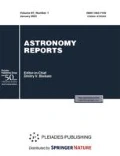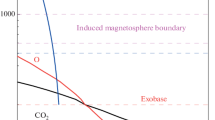Abstract—
We present a hybrid model and a magnetohydrodynamic (MHD) one for the solar wind plasma flow around Mars, which serve to calculate the flux of protons of the solar wind and the boundary of the induced magnetosphere. These parameters are used as input data for the kinetic Monte-Carlo model of the impact of a proton flux of the undisturbed solar wind on the daytime atmosphere of Mars. This model is intended to be used to determine the energy fluxes and the energy spectra of hydrogen atoms penetrating into the daytime upper atmosphere through the induced magnetosphere boundary. The obtained characteristics allow us to estimate the parameters of proton auroral phenomena, which were recently discovered in the upper atmosphere of Mars. Based on these characteristics, proton aurorae, which were observed with the Imaging UV Spectrograph (IUVIS) onboard the Mars Atmosphere and Volatile Evolution (MAVEN) spacecraft, can be calculated. The comparison of the results of these calculations with the observed characteristics opens up a unique opportunity to specify more accurately the properties of the atmosphere and the magnetic field of Mars, as well as enlarges a range of techniques used to determine the solar wind parameters.





Similar content being viewed by others
REFERENCES
F. Nagy, D. Winterhalter, K. Sauer, T. E. Cravens, et al., Space Sci. Rev. 111, 33 (2004).
E. Dubinin, M. Fraenz, J. Woch, E. Roussos, et al., Space Sci. Rev. 126, 209 (2006).
M. S. Chaffin, J. Y. Chaufray, D. Deighan, N. M. Schneider, et al., J. Geophys. Res. Planets 123, 2192 (2018).
Y. Futaana, J.-Y. Chaufray, H. T. Smith, P. Garnier, et al., Space Sci. Rev. 162, 213 (2011).
A. Hughes, M. Chaffin, E. Mierkiewicz, J. Deighan, S. Jain, N. Schneider, M. Mayyasi, and B. Jakosky, J. Geophys. Res. Space Phys. 124, 10.533 (2019).
J. Deighan, S. K. Jain, M. S. Chaffin, X. Fang, et al., Nat. Astron. 2, 802 (2018).
V. I. Shematovich, D. V. Bisikalo, J.-C. Gerard, and B. Hubert, Astron. Rep. 63, 835 (2019).
V. I. Shematovich, D. V. Bisikalo, and A. G. Zhilkin, Astron. Rep. 65, 203 (2021).
E. J. Weber and L. Davis, Jr., Astrophys. J. 148, 217 (1967).
L. D. Landau, E. M. Lifshits, Course of Theoretical Physics, Vol. 8: Electrodynamics of Continuous Media (Fizmatlit, Moscow, 2003; Pergamon, New York, 1984).
A. G. Zhilkin, A. V. Sobolev, D. V. Bisikalo, and M. M. Gabdeev, Astron. Rep. 63, 751 (2019).
D. V. Bisikalo, A. G. Zhilkin, and A. A. Boyarchuk, Gas Dynamics of Close Binary Stars (Fizmatlit, Moscow, 2013) [in Russian].
D. V. Bisikalo, A. A. Boyarchuk, V. M. Chechetkin, O. A. Kuznetsov, and D. Molteni, Astron. Rep. 43, 797 (1999).
J. S. Halekas, R. J. Lillis, D. L. Mitchell, T. E. Cravens, et al., Geophys. Res. Lett. 42, 8901 (2015).
C. Mazelle, D. Winterhalterm, K. Sauer, J. G. Trotignon, et al., Space Sci. Rev. 111, 115 (2004).
J. W. Chamberlain, Planet. Space Sci. 11, 901 (1963).
A. Rahmati, T. E. Cravens, A. F. Nagy, J. L. Fox, et al., Geophys. Res. Lett. 41, 4812 (2014).
A. Bößwetter, T. Bagdonat, U. Motschmann, and K. Sauer, Ann. Geophys. 22, 4363 (2004).
B. N. Gershman, Ionospheric Plasma Dynamics (Nauka, Moscow, 1974) [in Russian].
A. P. Matthews, J. Comput. Phys. 112, 102 (1994).
T. Bagdonat and U. Motschmann, J. Comput. Phys. 183, 470 (2002).
H. Shimazu, Earth, Planets Space 51, 383 (1999).
H. Shimazu, J. Geophys. Res. 106 (A5), 8333 (2001).
E. Kallio and P. Janhunen, J. Geophys. Res. 106 (A4), 5617 (2001).
E. Kallio and P. Janhunen, J. Geophys. Res. 107 (A3), 1035 (2002).
E. Kallio, K. Liu, R. Jarvinen, V. Pohjola, and P. Janhunen, Icarus 206, 152 (2010).
X.-D. Wang, M. Alho, R. Jarvinen, E. Kallio, S. Barabash, and Y. Futaana, J. Geophys. Res. Space Phys. 121, 190 (2016).
X.-D. Wang, M. Alho, R. Jarvinen, E. Kallio, S. Barabash, and Y. Futaana, J. Geophys. Res. Space Phys. 123, 8730 (2018).
J. L. Fox and A. B. Hac, Icarus 204, 527 (2009).
Y. Ma, A. F. Nagy, I. V. Sokolov, and K. C. Hansen, J. Geophys. Res. 109 (A7), A07211 (2004).
Y. J. Ma, X. Fang, A. F. Nagy, C. T. Russell, and G. Toth, J. Geophys. Res. Space Phys. 119, 1272 (2014).
C. Dong, Y. Ma, S. W. Bougher, G. Toth, et al., Geophys. Res. Lett. 42, 9103 (2015).
C. Dong, S. W. Bougher, Y. Ma, G. Toth, et al., J. Geophys. Res. Space Phys. 120, 7857 (2015).
Y. J. Ma, C. T. Russell, X. Fang, Y. Dong, et al., Geophys. Res. Lett. 42, 9113 (2015).
J.-C. Gerard, B. Hubert, B. Ritter, V. I. Shematovich, and D. V. Bisikalo, Icarus 321, 266 (2019).
ACKNOWLEDGMENTS
The computing facilities of the Joint Supercomputer Center of the Russian Academy of Sciences were used for this work.
Funding
The study was supported by the Russian Scientific Foundation (project no. 19-12-00370).
Author information
Authors and Affiliations
Corresponding author
Additional information
Translated by E. Petrova
Rights and permissions
About this article
Cite this article
Zhilkin, A.G., Bisikalo, D.V. & Shematovich, V.I. Numerical Model to Study Proton Polar Aurorae on Mars. Astron. Rep. 66, 245–254 (2022). https://doi.org/10.1134/S1063772922030076
Received:
Revised:
Accepted:
Published:
Issue Date:
DOI: https://doi.org/10.1134/S1063772922030076



